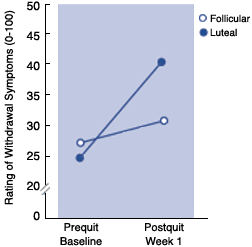 |

|
 Withdrawal symptoms for luteal-phase women 1 week after quitting smoking were significantly higher than those of follicular-phase women. Symptoms of irritability, anxiety, difficulty concentrating, restlessness, impatience, hunger, and depression were rated by participants on a scale ranging from 0 (none) to 100 (extremely intense). The graph illustrates mean values for
all symptoms combined. |
|
Women trying to quit smoking may be able to improve their success rate by starting their quit attempt on certain days of their cycle. In the course of the larger smoking cessation trial focused on weight issues, Dr. Perkins also examined tobacco withdrawal and mood measures for 78 premenopausal women who maintained smoking abstinence for 1 week after quitting. Half of the women quit during the follicular phase of their menstrual cycle (days 1 through 14) and half quit during the luteal phase (day 15 or later). He found that women quitting during the luteal phase reported significantly more tobacco withdrawal symptoms and depression than those who quit during the follicular phase.
"This research suggests a clear behavioral prescription for increasing the odds of success in quitting," says Dr. Perkins. "Women should set a quit date early in the follicular phase. Withdrawal symptoms and depression may be less intense. If withdrawal is blunted, quitting should be easier. And this simple strategy for timing the quit day costs nothing."
Volume 17, Number 4 (November 2002)
|
 |
|